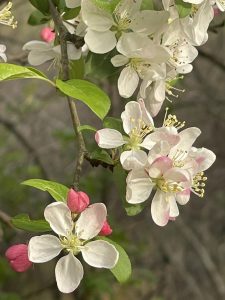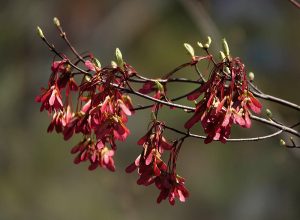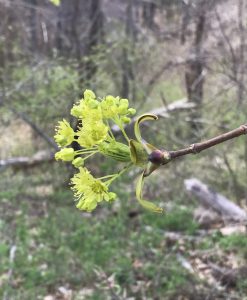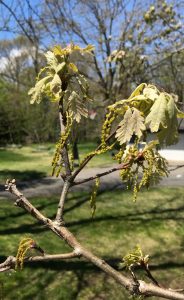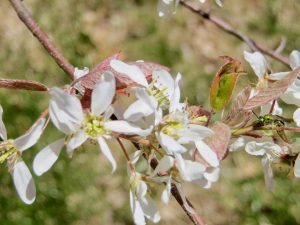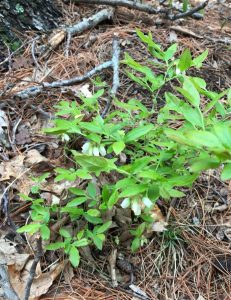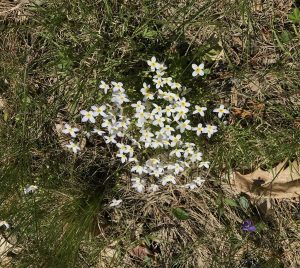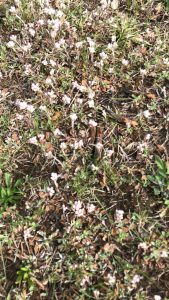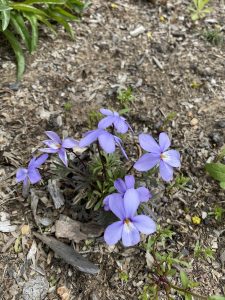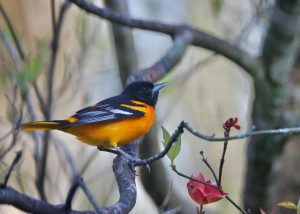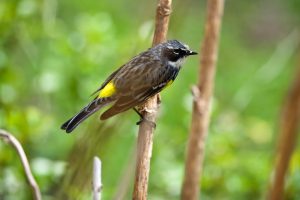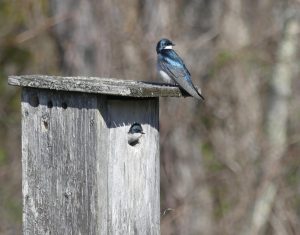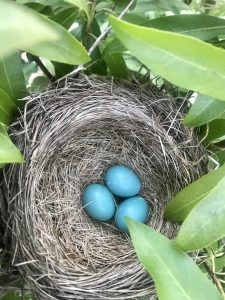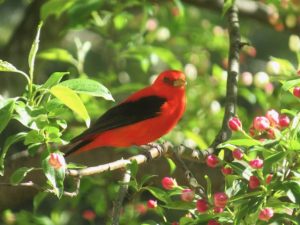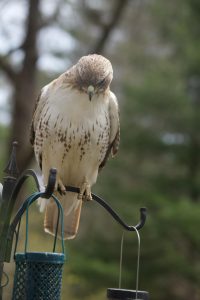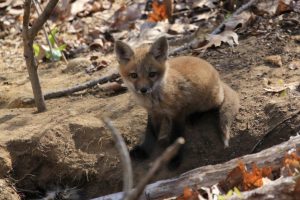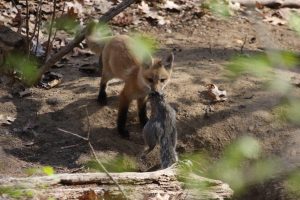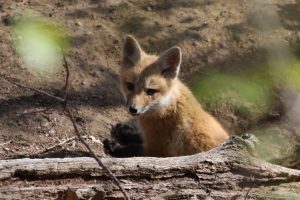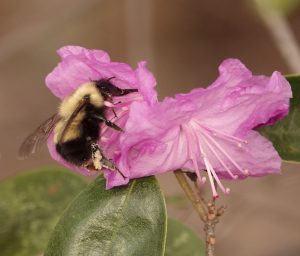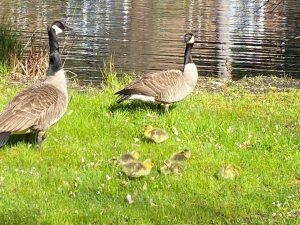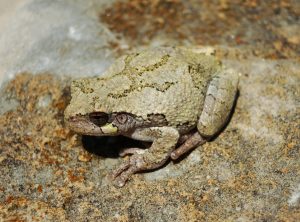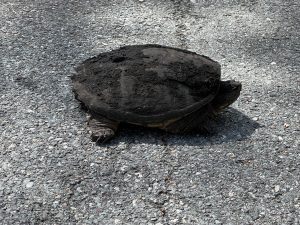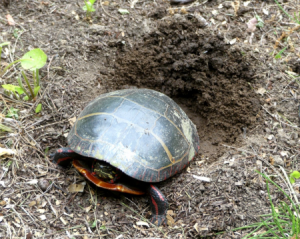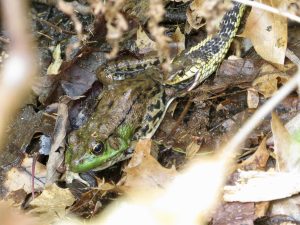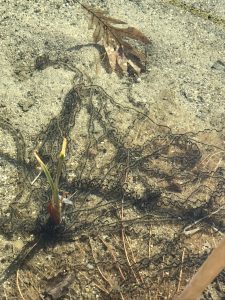Written by Gwyn Loud for the Lincoln Land Conservation Trust. She welcomes your sightings and questions at 781-259-8690 or gwynloud555@gmail.com.
The last week of April was chilly and very windy, but May dawned with a picture-perfect spring day and the world is bursting into bloom. We have had restorative showers, which is fortunate as rainfall was about an inch below normal for April. Many deciduous trees are on the verge of leafing out; spring is when we relish the the bright chartreuse shade of green, which will gradually morph into deeper green as we move into summer. Maples are already displaying their winged samaras (seeds), a deep red on red maples. Norway maples flowered with their unmistakable yellow-green blossoms and many other trees and shrubs are beginning to flower. Apple trees seem to have especially spectacular blossoms this year.
Thanks to much press about the importance of pollinators, we have become much more aware of the variety of wild insects needed to maintain our ecosystems. Until pine pollen coats our cars and windowsills and we start sneezing from allergies, we tend to forget that wind pollination is also important. Grasses, wildflowers, and trees which are wind pollinated lack showy and fragrant flowers as they do not need to attract insect pollinators. According to an informative newsletter from the Brandywine (PA) Conservancy, “ It’s estimated that around 10-20% percent of plants worldwide are wind-pollinated (including some that also entertain insects.)….. Oak flowers, for example, look like long dangling earrings: multiple strands (“catkins”) of small greenish flowers that catch the wind in any direction. The flowers of oaks and other wind-pollinated trees usually appear before new leaves, giving them unobstructed access to the breezes.” Pollen grains from wind-pollinated plants are small and light-weight; for example, we shall see the pollen from white pines floating on the breeze in yellow clouds in a few weeks.
In the woods, both high bush and low bush blueberries are flowering and will bear berries for wildlife food in months to come. Shadbush is blooming and Canada mayflower (aka wild lily-of-the-valley) carpets the forest floor in many places. This is the month to look for woodland wildflowers such as wood anemone, trillium, sessile bellwort, jack-in-the-pulpit, and lady’s slippers. Along roadsides greater celandine and ground ivy are blooming and dandelions are everywhere. Garlic mustard is in flower; please pull this invasive before it sets seed. In open places look for low-growing flowers such as pussytoes, Quaker ladies (aka bluets) and several species of violets.
The spring avian migration is at its peak, with newcomers arriving almost daily. Favorite colorful arrivals in Lincoln recently include Baltimore orioles, rose-breasted grosbeaks, scarlet tanagers, and ruby-throated hummingbirds. Birds such as wood thrushes, ovenbirds, Eastern towhees, and great-crested flycatchers are also back, but are in the woods and more easily heard than seen. Bluebirds, tree swallows, and house wrens are raising young in bird boxes, and barn swallows are swooping in and out of barns, where they nest. On Farrar Pond there are about twelve mute swans, but no nest so far, which means they may be immatures; mute swans do not breed until they are three years old. A bald eagle is nesting along the Sudbury River and great blue herons are nesting again in the wetland west of St. Anne’s Church. May is the month to admire goslings and ducklings, with fingers crossed that they survive being eaten by predators such as snapping turtles. Bobolinks have returned to breed in Farm Meadow after their amazing migration journey of more than 6000 miles from South America. Other arrivals of note include chimney swifts, gray catbirds, and several sparrow species: Savannah, swamp, chipping, and field. At the beginning of the month there were many ruby-crowned kinglets passing through on their way farther north.
Overall, our numbers of songbirds are alarming decreased. A study published in 2019 found that the population of birds in North America and Canada has declined by 2.9 billion since 1970. This includes birds in every biome and many of our common species, such as dark-eyed juncos, white-throated sparrows, and red-winged blackbirds. Personally, I see fewer birds around my feeders and in the summer in Maine. The reasons are many, from habitat loss to climate change to use of pesticides, among others. Millions of migrating birds also die from crashing into tall buildings brightly lit at night. To help, National Audubon and partners have established the Lights Out program where cities, including Boston, agree to turn off lights overnight during migration. Of course, this also saves, energy, money, and helps climate change.
Birders are always excited to see the colorful wood warblers arriving, hoping to find a “fallout” when conditions are just right. A few warblers, such as pine, yellow, and common yellowthroat will nest here but many are just passing through on their way to more northern states or Canada. Recent warblers spotted include yellow-rumped, palm, black-and-white, yellow, Northern parula, black-throated blue, blackburnian, black-throated green, Nashville, magnolia, mourning, and a Cerulean (very uncommon here). Often however, there are just one or two individuals of a species observed, part of the sad avian decline.
Spring is the season when one is most likely to find a baby bird on the ground or perhaps what seems to be an abandoned baby mammal. In nearly all cases it is best to leave it alone as, unknown to us, the parent is probably nearby, well aware of the situation and will take care of it. Rabbits especially stay away from their young so as not to attract predators.
Many of our common mammals, including white-tailed deer and woodchucks are either giving birth or tending young in May. Several people have reported seeing red foxes hunting for prey, no doubt to feed their kits. Residents at Farrar Pond Village have enjoyed watching red fox kits grow and expand their skills. Beaver are giving birth too; a Mass Wildlife publication explains, “Adult beavers have few predators and may live up to 20 years or more. They stay with the same mate for life and breed during winter (January through March). The females give birth to 1–9 kits inside a lodge between April and June. These kits stay with their parents through two winters before dispersing the following spring. A single family unit is called a colony, and is typically made up of 6–8 individuals; two adults, that year’s kits, and the young from the previous year.” A South Great road resident watched muskrats by a pond chew on small saplings in a beaver-like manner but the muskrat could not untangle the the saplings because invasive bittersweet was entwining them. People from various parts of town are noticing few chipmunks or none. The only explanation so far is that because last fall was a poor mast year, the chipmunks ran out of food such as acorns during the winter. We’ll see if they rebound.
Black flies are out, and we should keep watch for early butterflies such as small blue azures. Mining bees and cellophane bees have been out for awhile and we may see queen bumblebees zigzagging close to the ground as they look for nesting sites.
The warm weather has brought turtles out from their winter hibernation and painted turtles can be seen basking on rocks and logs on the shore of ponds. Naturalist Mary Holland writes about painted turtles: “A dark carapace (top shell) absorbs the sun’s heat, warming up the turtle’s internal temperature and the turtle regulates its temperature by shuffling in and out of the sun. It is imperative for the core body temperature of male Painted Turtles to reach 63° F., for only then can they start to produce sperm.” The females will lay their eggs in sandy soil between May and July.
American toads have been trilling loudly in recent days and I have found their double strings of eggs, looking like tiny black pearls, in shallow water. Next we can expect to hear the calls of the gray tree frogs and you might even find one against the outside of a low window, holding on with the sticky pads on its feet. The last frog of the season to start calling is the bullfrog, giving a deep jug-a-rum.
Looking skyward, we have the chance to see a total eclipse of the moon on May 15, the first of two in 2022. As explained in Astronomy Magazine, “The lunar eclipse begins with the penumbral shadow — a subtle shading barely visible on the Moon’s lower limb — at 9:32 P.M. EDT. The Moon reaches the dark edge of the deep umbral shadow at 10:27 P.M. EDT. Dusky gray first creeps across the lunar surface and, as more of the Moon sinks into the shadow, an orange coloring will become noticeable, particularly through a telescope. Totality lasts from 11:29 P.M. to 12:53 A.M., spanning 85 minutes (all times are EDT unless otherwise noted). Mid-totality occurs at 12:11 A.M. For observers along the eastern coast of the U.S., the Moon then stands at least 25° high in the southern sky.” Here’s hoping for cloudless skies on the evening of May 15!
© Gwyn Loud
Pertinent links:
To read more about what to do if you find “abandoned” baby birds or mammals
To read more about decline in songbirds


